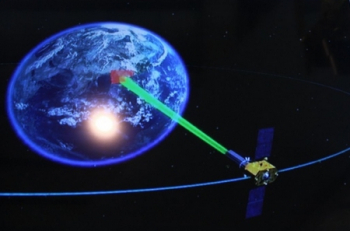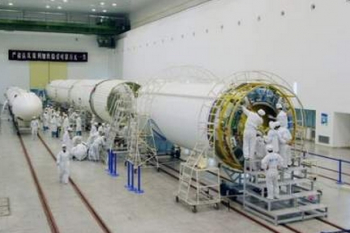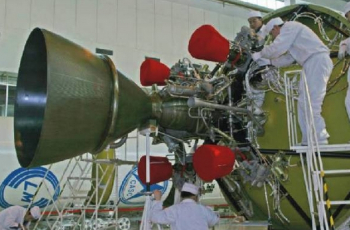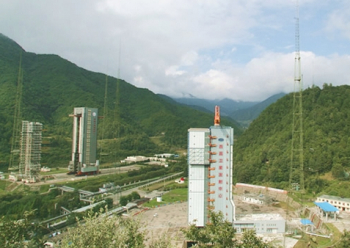Long March 3B lofts Gaofen-4 to close out 2015
December 28, 2015 by Rui C. Barbosa
The Chinese have closed out the year with the launch of its Long March 3B/G2 rocket. The launch involved the orbiting of a geostationary remote sensing bird, known as Gaofen-4 (GF-4). It was launched from the Xichang Satellite Launch Center at 16:05 UTC.
Chinese Launch:
Gaoden-4 is Chinas first geosynchronous orbit remote sensing satellite featuring a visible light and infra-red staring optical imager with a common optical system.
The optical resolution is better than 50 meters, while the infrared resolution is better than 400 meters. GF-4 can provide an imaging area of 7,000 km × 7,000 km with individual scene covering an area of 400 km × 400 km, and with capacity for high temporal resolution remote sensing monitor at minute-level. Launch mass is 4,600 kg. Gaofen-4 will be operational for 8 years.
The satellite combines the capacity of extremely high temporal resolution and high spatial resolution, optimal features that have various applications such as disaster monitoring, meteorological observation agriculture, national security, etc.
See Also
Gaofen-4 is the fourth satellite of the Gaofen series, but the third satellite of originally presented birds.
In May 2010, China officially initiated the development China High-Resolution Earth Observation System (CHEOS), which is established as one of the major national science and technology projects. The Earth Observation System and Data Center of China National Space Administration (EOSDC-CNSA) is responsible for organizing the construction of the CHEOS.
The Earth Observation System and Data Center, China National Space Administration was established in Mar. 2010. The Center is principally responsible for organizing and implementing as well as managing CHEOS. It is also responsible for EO application services, commercial development, technology consultant and international cooperation.
By following an arrangement of integral observation from space, air and ground, the CHEOS develops a space-based system, near space system, aerial system, ground system and application system as a whole to materialize earth observation at high temporal, spatial and spectral resolution, which is now in smooth progress. Overall, to meet the strategic demands of the national economic development and social progress.
The initial plan presented five satellites.
Gaofen-1 employs CAST2000 bus, configured with one 2 meter panchromatic / 8 meter multi-spectral camera and one 16m multispectral medium-resolution and wide-view camera. The satellite realizes an integration of imaging capacity at medium and high spatial resolution and with large swath, with designed lifespan of over 5 years. It was launched on April 26, 2013, and is now operational.
Gaofen-2 employs CS-L3000A bus, configured with one 1 meter panchromatic/4m multi-spectral camera, with designed lifespan of over 5 years. The satellite was launched on August 19, 2014.
Gaofen-3 employs CS-L3000B bus, configured with multi-polarized C band SAR at meter-level resolution, with designed lifespan of 8 years. Gaofen-3 is schedule for launch in 2016.
Gaofen-5 employs SAST5000B bus and is configured with six types of payloads, including visible and short-wave infra hyper-spectral camera, spectral imager, greenhouse gas detector, atmospheric environment infrared detector at very high spectral resolution, differential absorption spectrometer for atmospheric trace gas, and multi-angle polarization detector. It is designed for 8 years and is scheduled to launch in 2016.
On June 26, 2015, China launched the Gaofen-8 satellite. Developed by the China Aerospace Science and Technology Corporation (CASC), the satellite is part of a civilian program whose aim is to facilitate climate surveying, disaster response, precision agriculture mapping, urban planning and road network design.
Its imagery will be mostly used by the Ministry of Land and Resources, the Ministry of Environmental Protection, and the Ministry of Agriculture. The satellite was launched from the Taiyuan Satellite Launch Center using a Long March-4B rocket.
On September 14, 2015, another Gaofen satellite, Gaoden-9, was launched from the Jiuquan Satellite Launch Center, using a Long March-2D. Possibly a civilian version of the Yaogan Weixing-2 (Jianbing-6) satellite, Gaofen-9 will provide sub-meter class resolution optical images for city planning, road network design, land ownership determination etc. purposes.
Launch vehicle and launch site:
To meet the demand of international satellite launch market, especially for high power and heavy communications satellites, the development of Long March-3B (Chang Zheng-3B) launch vehicle was started in 1986 on the basis of the fight proven technology of Long March launch vehicles.
Developed from the Chang Zheng-3A, the Chang Zheng-3B is at the moment the most powerful launch vehicle on the Chinese space launch fleet.
The CZ-3B features enlarged launch propellant tanks, improved computer systems, a larger 4.2 meter diameter payload fairing and the addition of four strap-on boosters in the core stage that provide additional help during the first phase of the launch.
The rocket is capable of launching a 11,200 kg satellite to a low Earth orbit or a 5,100 kg cargo to a geosynchronous transfer orbit.
The CZ-3B/G2 (Enhanced Version) launch vehicle was developed from the CZ-3B with a lengthened first core stage and strap-on boosters, increasing the GTO capacity up to 5,500kg.
On May 14, 2007, the first flight of CZ-3B/G2 was performed successfully, accurately sending the NigcomSat-1 into pre-determined orbit. With the GTO launch capability of 5,500kg, CZ-3B/G2 is dedicated for launching heavy GEO communications satellite.
The rocket structure also combines all sub-systems together and is composed of four strap-on boosters, a first stage, a second stage, a third stage and payload fairing.
The first two stages – as well as the four strap-on boosters – use hypergolic (N2O4/UDMH) fuel while the third stage uses cryogenic (LOX/LH2) fuel. The total length of the CZ-3B is 54.838 meters, with a diameter of 3.35 meters on the core stage and 3.00 meters on the third stage.
On the first stage, the CZ-3B uses a YF-21C engine with a 2,961.6 kN thrust and a specific impulse of 2,556.5 Ns/kg. The first stage diameter is 3.35 m and the stage length is 23.272 m.
Each strap-on booster is equipped with a YF-25 engine with a 740.4 kN thrust and a specific impulse of 2,556.2 Ns/kg. The strap-on booster diameter is 2.25 m and the strap-on booster length is 15.326 m.
The second stage is equipped with a YF-24E (main engine – 742 kN / 2,922.57 Ns/kg; four vernier engines – 47.1 kN / 2,910.5 Ns/kg each). The second stage diameter is 3.35 m and the stage length is 12.920 m.
The third stage is equipped with a YF-75 engine developing 167.17 kN and with a specific impulse of 4,295 Ns/kg. The fairing diameter of the CZ-3B is 4.00 meters and has a length of 9.56 meters.
The CZ-3B can also use the new Yuanzheng-1 (Expedition-1″) upper stage that uses a small thrust 6.5 kN engine burning UDMH/N2O4 with a specific impulse at 3,092 m/s. The upper stage is able to conduct two burns, having a 6.5 hour lifetime and is capable of achieving a variety of orbits. This upper stage was not used on this launch.
Typical flight sequence for the CZ-3B/G2 sees the launch pitching over 10 seconds after liftoff from the Xichang Satellite Launch Centre. Boosters shutdown 2 minutes and 7 seconds after liftoff, separation from the first stage one second latter. First stage shutdown takes place at 1 minutes 25 seconds into the flight.
The separation between the first and second stage takes place at 1 minute 26 seconds, following fairing separation at T+3 minutes 35 seconds. Stage 2 main engine shutdown occurs 326 seconds into the flight, following by the shutdown of the vernier engines 15 seconds later.
The separation between the second and the third stage and the ignition of the third stage takes place one second after the shutdown of the vernier engines of the second stage. The first burn of the third stage will last for 4 minutes and 44 seconds.
After the end of the first burn of the third stage follows a coast phase that ends at T+20 minutes and 58 seconds with the third stage initiating its second burn. This will have a 179 seconds duration. After the end of the second burn of the third stage, the launcher initiates a 20 second velocity adjustment maneuver. Spacecraft separation usually takes place at T+25 minutes 38 seconds after launch.
The Xichang Satellite Launch Centre is situated in the Sichuan Province, south-western China and is the countrys launch site for geosynchronous orbital launches.
Equipped with two launch pads (LC2 and LC3), the center has a dedicated railway and highway lead directly to the launch site.
The Command and Control Centre is located seven kilometers south-west of the launch pad, providing flight and safety control during launch rehearsal and launch.
Other facilities on the Xichang Satellite Launch Centre are the Launch Control Centre, propellant fuelling systems, communications systems for launch command, telephone and data communications for users, and support equipment for meteorological monitoring and forecasting.
The first launch from Xichang took place at 12:25UTC on January 29, 1984 when the Chang Zheng-3 (Y-1) was launched the Shiyan Weixing (14670 1984-008A) communications satellite into orbit.
Long March 3B lofts Gaofen-4 to close out 2015 | NASASpaceFlight.com






















